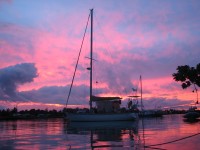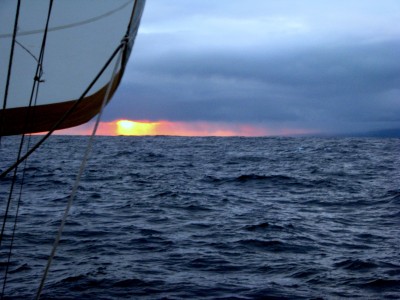Sailing Leander
Sailing Leander

Who: Sima Baran & Paul Robertson
Port: Boston
Favorites
22 November 2010 | Fethiye, Turkey
22 October 2010
20 July 2010 | Endeavor Bay, Tawila Island, Egypt
17 July 2010 | Red Sea, Egypt
15 July 2010 | 27 41 N, 33 48 E
14 June 2010 | 14 48 N, 42 57 E
12 June 2010
08 June 2010 | Sataya (Dolphin) Reef, Red Sea, off the coast of Egypt
07 June 2010 | Dangerous Reef, Foul Bay, Egypt
02 June 2010 | Khor el Morob, Sudan
30 May 2010 | Marsa Shin'Ab, Sudan
27 May 2010 | Marsa Shin'ab, Sudan
25 May 2010 | Suakin, Sudan
24 May 2010 | Aden, Yemen
03 May 2010 | Day 5: 160 miles northeast of Aden, 15 miles from the Yemeni Coast
29 April 2010 | Day 1: Passage to Yemen
24 April 2010 | Day 16: 135 Miles From Salalah, Oman
21 April 2010 | Day 13: 460 Miles From Salalah, Oman
19 April 2010 | Day 11: A Little Bit Closer to Oman
18 April 2010 | In the midst of the Arabian Sea
Galapagos at night
04 August 2008 | San Cristobal, Galapagos
Paul

We made the Galapagos this morning at about 1 a.m. It was a night entry, but relatively easy because the chart plotter and radar were dead on and because the entrance was well marked.
This seems like a magical place. As we came in, sea lions danced and played around the boat, and then snorted about as we prepared to drop anchor. They skedaddled away when the chain rolled out of the locker and crashed into the water, but came back after a few moments. As I type this, they can be heard out and about, mooing like cows and whooping like beagles.
The trip was not too bad. We got blasted with a nasty lightning storm and a heavy downpour the night we left. The squalls continued for the next several days. This rainy season stuff is for the birds. For two and a half days, at the start, we watched on the radar as squalls tracked us down and then unloaded on us. You'd finally get through, after a couple of hours of it slowly passing over you, and you'd look at the radar to see another one lining up for a repeat show a couple of hours away. It was worse when the squalls were traveling in the same direction as us, because then the two hours would become five.
That is the scene in and around the ITCZ (the "Intertropical Convergence Zone"), better known as the doldrums, which sits just north of the equator. It is typified by violent thunderstorms and light winds. The winds aren't too terrible in the storms, but the electrical storms can sometimes be something to behold, and the rain can feel like there are 15 fellows with fire hoses trained at the very spot where you are cowering underneath the bimini.
(Holy cow!!!!! I nearly jumped out of my seat just now! A sea lion has come up to the back of the boat and started braying like a banshee. Scared the daylights out of me!)
We got through the doldrums, sailing due south out of Panama Bay, along the entire coast of Colombia, to about the middle of Ecuador. We couldn't sail a direct line to the Galapagos because the winds blow straight from there to Panama. So you've got to sneak in the backdoor, going south, tacking once a day, until you can finally take a right hand turn to drive straight at the island. Those big tacks can be hard on the spirit, as one would sail 100 miles or so total distance under the keel in a 24 hour period, but only make 50 miles or as the crow flies. Add into that the persistent rain, and it made for a hard first week. We were a mere 20 miles from the Ecuadorian cost, and only a few hundred miles from Peru. We could see the glow of the local Ecuadorian towns at night. It would be nice to take detours and spend a couple of weeks there, but we've got a limited window of time to get to New Zealand.
(Now the sea lion is doing laps around and under the boat. Underwater sounds can echo through the hull, and you can hear him noisily swishing by under the hull. It feels like the aquarium in reverse, with him playing around on the outside, curious about us, here on display for him on the inside.)
But when we finally did make the turn to the Galapagos, it was pleasant sailing then on. We did about 150 miles a day, and there was no more rain. Yay!
But it has continued to be overcast. And, stunningly, cold! We've been moving south for the last 9 months or so, and it has gotten progressively hotter. But when we made the right hand turn off the coast of Ecuador, we picked up the north-setting "Humboldt" or "Peru" current. Just like the Gulf Stream warms things in its path, the Humboldt Current chills everything along its route. We wore hooded sweatshirts and pants on watch at night. It's the same here in the Galapagos, which enables penguins, sea lions, and fur seals to thrive
Time for bed. It's been a long sail, and I can barely keep my eyes open
This seems like a magical place. As we came in, sea lions danced and played around the boat, and then snorted about as we prepared to drop anchor. They skedaddled away when the chain rolled out of the locker and crashed into the water, but came back after a few moments. As I type this, they can be heard out and about, mooing like cows and whooping like beagles.
The trip was not too bad. We got blasted with a nasty lightning storm and a heavy downpour the night we left. The squalls continued for the next several days. This rainy season stuff is for the birds. For two and a half days, at the start, we watched on the radar as squalls tracked us down and then unloaded on us. You'd finally get through, after a couple of hours of it slowly passing over you, and you'd look at the radar to see another one lining up for a repeat show a couple of hours away. It was worse when the squalls were traveling in the same direction as us, because then the two hours would become five.
That is the scene in and around the ITCZ (the "Intertropical Convergence Zone"), better known as the doldrums, which sits just north of the equator. It is typified by violent thunderstorms and light winds. The winds aren't too terrible in the storms, but the electrical storms can sometimes be something to behold, and the rain can feel like there are 15 fellows with fire hoses trained at the very spot where you are cowering underneath the bimini.
(Holy cow!!!!! I nearly jumped out of my seat just now! A sea lion has come up to the back of the boat and started braying like a banshee. Scared the daylights out of me!)
We got through the doldrums, sailing due south out of Panama Bay, along the entire coast of Colombia, to about the middle of Ecuador. We couldn't sail a direct line to the Galapagos because the winds blow straight from there to Panama. So you've got to sneak in the backdoor, going south, tacking once a day, until you can finally take a right hand turn to drive straight at the island. Those big tacks can be hard on the spirit, as one would sail 100 miles or so total distance under the keel in a 24 hour period, but only make 50 miles or as the crow flies. Add into that the persistent rain, and it made for a hard first week. We were a mere 20 miles from the Ecuadorian cost, and only a few hundred miles from Peru. We could see the glow of the local Ecuadorian towns at night. It would be nice to take detours and spend a couple of weeks there, but we've got a limited window of time to get to New Zealand.
(Now the sea lion is doing laps around and under the boat. Underwater sounds can echo through the hull, and you can hear him noisily swishing by under the hull. It feels like the aquarium in reverse, with him playing around on the outside, curious about us, here on display for him on the inside.)
But when we finally did make the turn to the Galapagos, it was pleasant sailing then on. We did about 150 miles a day, and there was no more rain. Yay!
But it has continued to be overcast. And, stunningly, cold! We've been moving south for the last 9 months or so, and it has gotten progressively hotter. But when we made the right hand turn off the coast of Ecuador, we picked up the north-setting "Humboldt" or "Peru" current. Just like the Gulf Stream warms things in its path, the Humboldt Current chills everything along its route. We wore hooded sweatshirts and pants on watch at night. It's the same here in the Galapagos, which enables penguins, sea lions, and fur seals to thrive
Time for bed. It's been a long sail, and I can barely keep my eyes open
Comments
| Vessel Name: | Leander |
| Vessel Make/Model: | Bristol 41.1 |
| Hailing Port: | Boston |
| Crew: | Sima Baran & Paul Robertson |
| About: | Following our wedding in Istanbul we are taking a two-year break from land-life and going sailing. Sima is taking time off between strategy consulting and business school while Paul is on a sabbatical from his career as an attorney. |
Gallery not available
Sailing Leander

Who: Sima Baran & Paul Robertson
Port: Boston